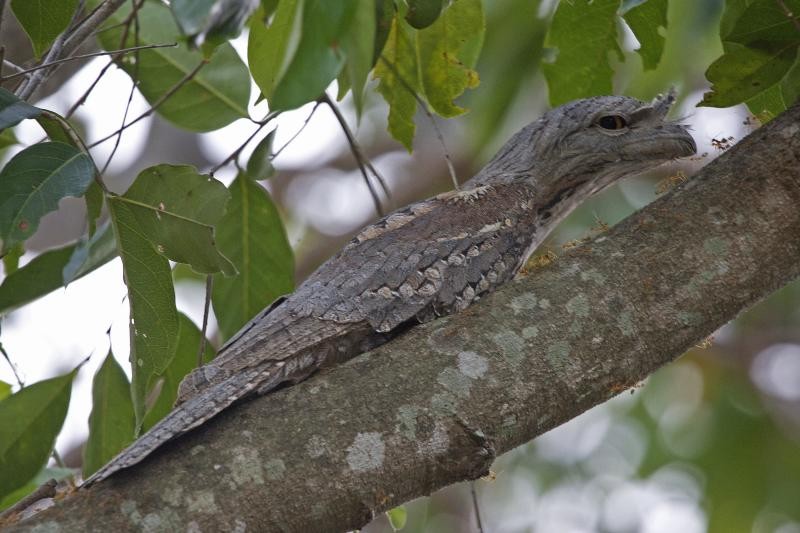Tawny Frogmouth
A species of Australo-papuan Frogmouths Scientific name : Podargus strigoides Genus : Australo-papuan Frogmouths
Tawny Frogmouth, A species of Australo-papuan Frogmouths
Botanical name: Podargus strigoides
Genus: Australo-papuan Frogmouths
Content
Description People often ask General Info
 Photo By Lip Kee Yap , used under CC-BY-SA-2.0 /Cropped and compressed from original
Photo By Lip Kee Yap , used under CC-BY-SA-2.0 /Cropped and compressed from original Description
Tawny frogmouths are large, big-headed birds that can measure from 34 to 53 cm (13 to 21 in) long. Weights have been recorded up to 680 g (1.50 lb) in the wild (and perhaps even more in captivity), but these are exceptionally high. In the nominate race, 55 males were found to weigh a mean of 354 g (12.5 oz), while 39 females weighed a mean of 297 g (10.5 oz), with a range between both of 157 to 555 g (5.5 to 19.6 oz). Among the subspecies P. s. brachypterus, 20 unsexed birds were found to average 278 g (9.8 oz) with a range of 185 to 416 g (6.5 to 14.7 oz). In P. s. phalaenoides, a weight range of 205 to 364 g (7.2 to 12.8 oz) was reported. Thus, in terms of average if not maximal body mass, the tawny is a bit smaller than its relative, the Papuan frogmouth. Tawny frogmouths are stocky and compact with rounded wings and short legs. They have wide, heavy, olive-grey to blackish bills that are hooked at the tip and topped with distinctive tufts of bristles. Their eyes are large and yellow, a trait shared by owls. However they are not forward facing like an owls. Tawny frogmouths have three distinct colour morphs, grey being the most common in both sexes. Males of this morph have silver-grey upperparts with black streaks and slightly paler underparts with white barring and brown to rufous mottling. Females of this morph are often darker with more rufous mottling. Females of the subspecies P. s. strigoides have a chestnut morph and females of the subspecies P. s. phalaenoides have a rufous morph. Leucistic or albinistic all-white aberrant plumage for this species has been documented. 
Size
53 cm
Colors
Gray
Life Expectancy
10 years
Nest Placement
Tree
Feeding Habits
Tawny Frogmouth primarily consume nocturnal insects, spiders, worms, and other invertebrates, supplementing with small vertebrates. They pounce from perches to capture prey, showing precision with their beaks. Handling prey varies from pulping insects to bashing larger animals before swallowing.
Habitat
Tawny Frogmouth are predominantly found in varied woodland and forest settings, scrublands, and heathlands, as well as in savannah areas rich with river gums and casuarinas. Broadly, they inhabit regions that offer trees and shrubs for roosting and nesting, along with open spaces suitable for hunting. While avoiding dense rainforests and treeless deserts, tawny Frogmouth readily adapt to human-altered environments, including suburban parks and gardens. Their nesting is more abundant in open-canopy woodlands compared to dense forest areas.
Dite type
Frugivorous
People often ask
General Info
Feeding Habits
Bird food type

Fruit
Bird Feeder Type

Platform
Distribution Area
Tawny frogmouths are found throughout most of the Australian mainland except in far western Queensland, the central Northern Territory, and most of the Nullabor Plain. In Tasmania, they are common throughout the northern and eastern parts of the state. They can be found in almost any habitat type, including forests and woodlands, scrub and heathland vegetation, and savannahs. However, they are rarely seen in heavy rainforests and treeless deserts. They are seen in large numbers in areas populated with many river gums and casuarinas, and can be found along river courses if these areas are timbered. Tawny frogmouths are common in suburbs, having adapted to human presence. They have been reported nesting in parks and gardens with trees. 
Species Status
The conservation status of tawny frogmouths is "least concern" due to their widespread distribution. However, a number of ongoing threats to the health of the population are known. 
Scientific Classification
Phylum
Chordates Class
Birds Order
Nightjars and Relatives Family
Frogmouths Species
Tawny Frogmouth